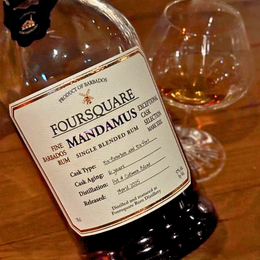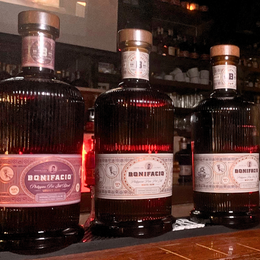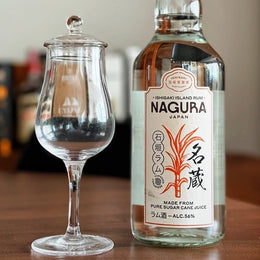Editor's note: This is Part 3 of Jigs' 3-part series on Luisita Rum. Jigs interviews Paco Cojuangco, Luisita Rum's "Farmer Behind the Brand" about the brand's fascinating history, production process, philosophy on rum and the future plans of Luisita, and he also reviews three bottles of Luisita's rums. This third part focuses on the brand's vision and future plans. Read Part 1 here and read Part 2 here.

“It all ties back to the farming and the community.”
This is final piece in my series of reviews on Luisita Rum. For those who are tuning in to this series for the first time with this review, much of the articles’ content has focused on my conversation with Luisita’s “Farmer Behind the Brand,” Paco Cojuangco. We conclude that conversation with his philosophy on the brand and on rum, in general, as well as current and future developments with the brand.

[Jigs]: What is your vision for Luisita rum?
[Paco]: The vision for Luisita is, on the deepest level, being able to continue the community and what has been started here. The previous generations have left their mark; the mill and plantation are still here, and the estate is still surrounded by the same community comprising ten barangays or baryos. We want to give back and work with the people who work with the land, so in a way, this project is my homage to the Luisita estate. I was part of the founding team of the brand, and the ambition is to let the brand live for as long as it can; hopefully, it stays forever and can be a mainstay. Hopefully, people can look back at this conversation and other interviews and see the history surrounding it. By staying premium, authentic, and playing up the heritage and community, we’ll be able to fulfill that goal.
Luisita is also my way of showing what comes out of my neck of the woods, that it’s not just sugar, and uplifting it to the level alongside other premium Philippine products to show the world what we’re capable of. There’s a silent wave of global Filipino pride that aims to prove that we can produce world-class products, so the goal is to keep our rum of quality.

[Jigs]: What is your perception of “quality”? How would you describe “a rum of good quality”?
[Paco]: It’s very sensory-oriented for me. Now, I don’t want to romanticize it and simply associate quality with taste; no, a lot of it is technical, and there’s a lot of math, chemistry, and studying that comes with it. As I explained, we already have the existing distillery, and I’m just a steward, so the philosophy for quality is rooted in that heritage.
“Adulterated” is a strong word, but I believe that when a product, aged or not, veers away from the traditional way that it is made, the final product won’t surpass a product was made naturally or traditionally.
“Adulterated” is a strong word, but I believe that when a product, aged or not, veers away from the traditional way that it is made, the final product won’t surpass a product was made naturally or traditionally. Technologies that speed up aging, for example, are not going to have the same effect as leaving rum in a barrel for four, five, or six years. Even as I’ve grown my collection of rum, it’s easy to feel and taste which brands make rum with tradition, passion, and authenticity and which brands produce rum only for profit – though, of course, we all still have to earn a buck at the end of the day. You can also tell when someone does it for fun, so I like to keep the fun there even if the process is technical or arduous. I think the moment producers lose fun, quality might not drop, but they can only take their products so far. For me, fun involves a pursuit of flavor, so I believe that keeping that pursuit – whether expressed through experimenting, tasting, or blending – in my life will translate to what most people also take to be “quality” in rum.

[Jigs]: Among rum enthusiasts, rum from the Philippines is known to contain additives like sugar and color. What are your views on the practice of adding sugar, spices, or coloring to rum?
[Paco]: Actually, I have barrels of rum that have added sugar, but I had to do it because I wanted to know. I do enjoy some releases from Plantation, and I enjoy the Don Papa Sherry Cask – I believe they all have their respective place. Different styles exist, so what matters more to me is when brands are true to their own style. And while I get the allure of styles with additives, I wouldn’t do it.
For Luisita, quality will always still remain with simply expressing what time and the land are able to produce. We don’t want to try to control it too much; we just want to create the perfect conditions in every step and see what happens afterward. We’ve been approached by a few flavor houses to make spiced rum. Initially, when we were still new to the game, we were thinking about wanting to add some maple syrup flavors. We were shown that world of flavors and spices, and we tried playing around with it just so that we knew. However, we felt that it didn’t fit the style nor do our rum justice. We had waited so much time just to add spices, sugar, or color in – it doesn’t work for Luisita. Adding those things will cause Luisita, based on our vision for it, to no longer be a quality product. For other brands, if additives enhance their product, I get it. We would’ve done the same if additives enhanced our rum, but that’s not the case.

[Jigs]: What is your view on cask management when aging rum in the Philippines? For you, how does age figure in quality?
[Paco]: Cask aging plays a very big factor. We were always told that it would be fast in a tropical country, but no one prepared us for exactly how fast that would be. Our Luisita Oro blend is just a two-year-old rum with some three-year-old in it; the color can be acquired in two years and will max out in three-and-a-half to four years in an ex-bourbon barrel. I don’t foresee having a barrel that’s older than 10 or 12 years only because it might be too woody unless it’s some of the newer make we had barreled in the last three years. In all, I’m glad the rum ages well here in Luisita. I’m still trying to understand the effect it’ll have. Here in Tarlac, we’re landlocked, so the humidity is like the rest of the country for six months of the year, but then we hit this dry period where the temperature will be as low as 16 to 22 degrees, especially in January and February, with relative humidity at 40 to 50 percent. That speeds up our aging process, so in a way, I’m happy that we’re in a tropical country. It allows us to do things faster and discover more flavors in our lifetime. This is also why I’m thinking of pushing out a few more blends because my fear is that the earlier batches we made, which used a lighter distillate, might get too woody if I let them age in the next two to four years. It’s aging faster than anyone could have ever warned us, and we were already warned by many people.
In a way, I’m happy that we’re in a tropical country. It allows us to do things faster and discover more flavors in our lifetime.
In terms of cask management, we’re also now finding that the use of second- and third-fill barrels will help us slow the aging down. I’m thinking that maybe I’d want to release rum that will have an age statement as a novelty product, and those barrels can make that possible. The aging is slower, gentler, and has a completely different flavor profile – again, there’s fun with pursuing that idea. I wish we had a cooperage in the country so we could play around with native wood, but until that comes along, I have too much on my plate and can’t get into that. It’d be cool to try out barrels made from mango wood or tamarind wood. The possibilities are boundless, especially also because of the fast aging, and I can imagine the same to be true for other local producers.
[Jigs]: I understand that the brand recently began distributing in Singapore. What approach do you take when deciding on how or where to build the brand overseas?
[Paco]: Originally, we were thinking of distributing to Europe – really, just to follow the footsteps of Don Papa – and countries like Italy, France, and Germany. Then, I was looking at other brands and joined online rum communities, and Singapore kept popping up. There seemed to be a strong community there. Population-wise, it’s not big, but I met someone who told me in the latter part of 2021 or early 2022 that Singapore is the “showroom of Asia.” I started digging into it more, and it appears that was the case. I know a lot of people in Singapore who work for multinationals, and they easily do business. Turns out, the same was true for spirits. It made sense to have the rum there as our first salvo so that other countries can see what we’re doing. True enough, in the year that we’ve been there, two other parties from different countries approached us with some interest in having their own single barrel. It’s kind of like a gateway to the rest of the world.
After Singapore, we’re definitely eyeing surrounding countries like Japan, Taiwan, and Australia. Then, we’d go for Europe. Eventually, the United States would probably be the last stop. I went to the 2018 Miami Rum Festival in Florida, and there was a big tiki scene, too. It’ll take time, of course.

[Jigs]: How would you synthesize what you enjoy the most about being the “farmer behind the brand”?
[Paco]: As cheesy and cliché as it would sound, it’s really the community. We have three core values for Luisita: community, heritage, and authenticity. Those were really instilled in me, growing up, coming from a family revolving around sugarcane and politics. We were raised to recognize the value of the partnership with the farmers. There’s satisfaction in knowing that because of the rum, we are slowly able to offer more for molasses and increase profitability for the farmers and help them feel proud about planting the rum. That makes me happy, and being able to philosophically uplift the crop and the community brings me joy. “Farmer behind the brand” is exactly who I am; I’ll never stop being a farmer, and it just so happens that I have a rum brand that comes with it. It all ties back to the farming and the community. A lot of the members of our team are from the same area, too.
We were raised to recognize the value of the partnership with the farmers. There’s satisfaction in knowing that because of the rum, we are slowly able to offer more for molasses and increase profitability for the farmers and help them feel proud about planting the rum. That makes me happy, and being able to philosophically uplift the crop and the community brings me joy.
For example, our 73-year-old cellar master’s first job at 18 years old was to work for the distillery, and he has no intention of leaving. Our General Manager, Chuchi, has also been with us since the ‘80s. Juvy, one of our distillery women, is the third generation in her family to work in the organization. There’s joy working with people I saw growing up, working with their children, and fostering all those relationships through the brand.
[Jigs]: Are there any developments with Luisita that you want readers to know about?
[Paco]: The big news is that we have a small pot still that just came in. It’s a new toy that’s gonna give us a lot of headaches, haha! We already distilled our first batch of water – this is the first step just to clean the pot still and learn about the still while avoiding costly mistakes.
As for releases, there will be more private cask releases. There has been some interest in it, so we’re really happy about that, too. The Small Batch will be coming out this year, 2023; it’s all ready to go apart from permits and taxes, so we just need to get those done. Some time next year, expect to see our new make on the market, but primarily for the bar scene and export. It’s funny: I started bringing unaged rum to classes and tastings just to show how the aged rum we sell is different, but a lot of people kept asking if the new make is in the market. It’s great feedback, though, so we’re already working toward that release. I haven’t quite figured it out yet, but the pot still rum we’ll eventually release will be a game-changer. I’m excited to see what flavors can come from pot-distilling our molasses and perhaps even the use of open fermentation.
– – –
This concludes my conversation with Paco about Luisita. As I’ve personally expressed to him, I’m grateful for the time and passion he has shared with me and with readers; the depth of knowledge presented in this series of reviews will not exist without him agreeing to chat in the first place.
As someone who has fallen head-over-heels with rum, I am thrilled to finally have a local Philippine rum brand that I can rally behind, one that gives me hope for seeing Philippine rum on the map as a category that holds its own against the existing giants in the rum industry. The best part of my elation? The rum, itself, is consistently far from mediocre.
Luisita Single Barrel (PX-1003) Philippine Rum, 62.0% ABV – Review

This last single-barrel, single-estate rum that I’ll be reviewing has been exclusively matured in an ex-Pedro Ximénez sherry cask (no. PX-1003). It is also six years old, also comes from a crop harvested in 2015, and is naturally presented at 62% strength. I purchased this bottle for $89.
Nose: Relatively dark and heavy but with a tinge of sweetness. A mixture of sesame oil, oyster sauce, burnt pork barbecue, and brown sugar anchors the nose. Surrounding that core are layers of atsuete oil, earthy and over-brewed coffee, and tamarind candy. The synthetic rubber of diving masks and Pei Pa Koa (loquat syrup commonly used in the Philippines to sooth sore throats). Over time, very subtle fruity aromas emerge: dried plums, figs, and chico.
Palate: Following the nose's character, the palate is also heavy, with a moderately thick yet oily texture. The development begins with bitter coffee, motor oil, and blackened banana peels before taking a minute step toward burnt Biscoff cookies and old anise. It doesn't move much past there, even with time, although there are flitting hints of dark chocolate, garam masala, and ground chickpeas.
Finish: Still a long finish and with some oiliness remaining, too. Roasted bell peppers and smoked cherry wood.
My Thoughts
Most of my previous experiences with ex-PX casks lean toward sweeter flavors, so I'm quite surprised that this rum was heavier and had synthetic flavors. Though at the cost of balance, the cask influence clearly creates a distinct character and complexity that I like but without being overdone to the point that the heft becomes unbearable. I would've liked it more if Luisita's house style was more noticeable, but I guess it was overwhelmed enough for that style to be a little muted. With that said, the rum expresses the cask influence well; I'm certain that a lot of sherry-heads would love this. For this rum, the price of $89 isn't bad at all, but I do hope that prices don't keep rising up as fast as it has the past couple of years.
Unless otherwise stated, all images are courtesy of Jigs Alonzo/@thebrowndram.

The Brown Dram
A Filipino living in Metro Manila, Jigs is a whisky and rum enthusiast. His passion for spirits has led him to develop interests in photography and, now, writing. Reach him and check out his work on Instagram @thebrowndram!







